Essential numbers for navigating job market challenges and enhancing student success.
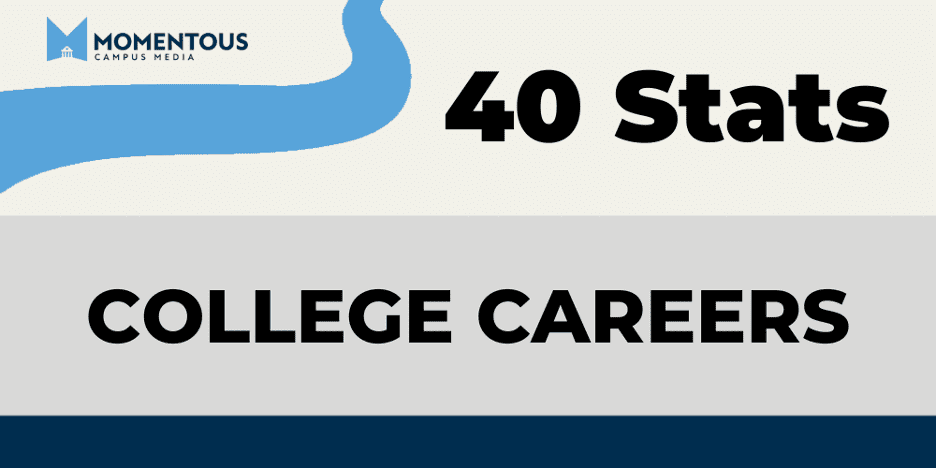
The Class of 2024 faces a promising yet competitive U.S. job market. High-demand degrees and internships boost prospects, but challenges like salary expectation disparities and student debt persist.
To help students succeed, college career advisors offer services that are proven to help students find the crucial first job. However, to help students, these departments must work to engage with them earlier in the process.
General College Career Stats
- 76.6% of employers rate the job market for Class of 2024 graduates as “good” to “excellent” (NACE).
- In December 2023, the unemployment rate for recent college graduates in the U.S. was approximately 4.8%. (Source: Statista)
- Only 18% of recent grads were able to line up a job before graduation. (Neighbor)
- Four years after completing their bachelor’s degrees, roughly 74% of graduates were employed full-time, with another 7% working part-time. (National Center for Education Statistics)
- About 19% of the roughly 2 million bachelor’s degrees conferred in 2019-20 were in Business, making it the most common major. (Source: Niche)
- Total employment in the U.S. is projected to grow by nearly 4.7 million from 2022 to 2032, particularly in sectors like health care and social assistance. (Source: Bureau of Labor Statistics)
- 52% percent of college graduates were underemployed one year after graduation — meaning they were working in jobs that don’t typically require a bachelor’s degree. (Fordham Institute)
- Hiring for new grads is projected to dip by 1.9% in 2024 compared to 2023 (NACE)
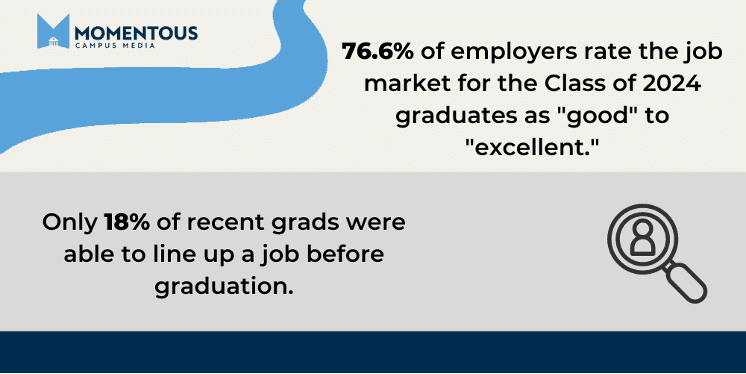
Wage Stats For Careers After College
- In 2021, college graduates aged 22-27 earned a median annual wage of $52,000, compared to $30,000 for their peers with only a high school diploma. (College Scorecard)
- Graduates with engineering, computer science, and healthcare degrees consistently rank among the highest earners, with average starting salaries exceeding $65,000. (Georgetown University Center on Education and the Workforce)
- The minimum salary students say they’d accept at their first job is $72,580 — 30% higher than the actual average salary of $55,911. (CNBC)
- 64% of recent graduates say they don’t earn “enough” to cover their bills and discretionary spending. (Neighbor)

Diversity Stats For Careers After College
- The average number of job offers to women versus men is 1.11 vs. 1.18.
- A smaller percentage of 2021 female graduates (53%) were employed six months after graduation compared to males (58%).
- This gap is also reflected in starting salaries, with a disparity of over $11,000 between genders. (Forbes)
- The average salary of a 25-34-year-old Asian-American worker with a bachelor’s degree is $69,670, followed by $65,000 for White workers, $52,000 for Hispanic workers and $49,970 for black workers. (Bankrate)
- 82.5% Percent of employers have diversity recruiting efforts. (NACE)
- In the UK, an anonymous application process leads to 117% increase in BAME (Black, Asian, Minority Ethnic) candidates. (Onrec)
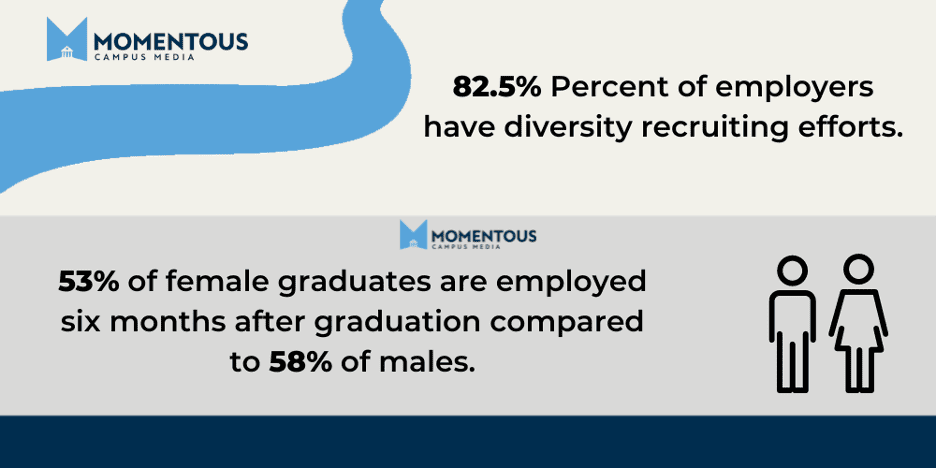
What Employers Are Looking For In Recent College Graduates
- 80% of employers believe higher education prepares college graduates for workforce success. (Higher Ed Dive)
- 77% of students expressed concerns about whether they had the skills needed for a job. (Inside Higher Ed)
- 95.5% percent of employers cite Communication as the most important competency. (NACE)
- 37% percentage of employers who screen candidates by GPA, down from 46.3% in 2022 and 67.5% in 2017. (NACE)
- 53% of employers say that recent college graduates struggle with eye contact during interviews. (Intelligent)
- 38% of employers avoid hiring recent college graduates in favor of older employees. (Intelligent)
- Nine out of 10 U.S. employers report a reliance on U.S.-based employees with language skills other than English. (ACTFL)
- But only 10% of college graduates have studied a second language. (Preply)
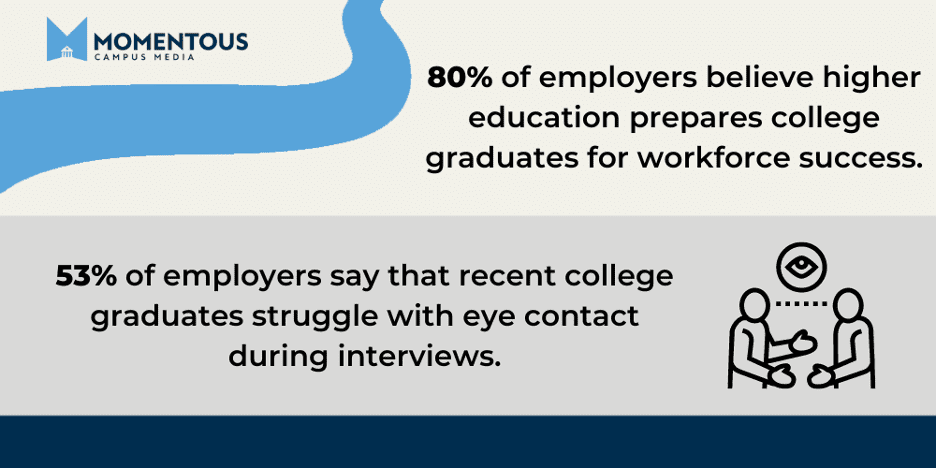
Importance Of College Internships In Starting A Career
- 66.4% of interns secure a full-time job offer with the company they interned at. (FlairHR)
- Interns who land full-time positions after their internship experience can expect a starting salary $15,000 higher than non-interns. (FlairHR)
- Internship experience increases a graduate’s chance of receiving at least one job offer by up to 32% in the months following graduation. (Zippia)

Effect Of Student Debt On Starting A Career
- The average student loan debt for bachelor’s degree recipients was $29,400 for the 2021-22 school year. (CNN)
- 70% of college seniors with student debt say looming repayments will impact their career plans. (CNBC)
- 871,000 borrowers have received loan forgiveness through the Public Service Loan Forgiveness (PSLF) program since 2021. (Forbes)

Freelance And Gig Work Stats For College Graduates
- 68% of 2023 grads are considering starting their careers freelancing. (Business Insider)
- 69% of recent graduates do gig work, with 31% reporting that as their main source of income. (Neighbor)
- 41% percent of students say they’re more likely to apply to a hybrid job. (Handshake)
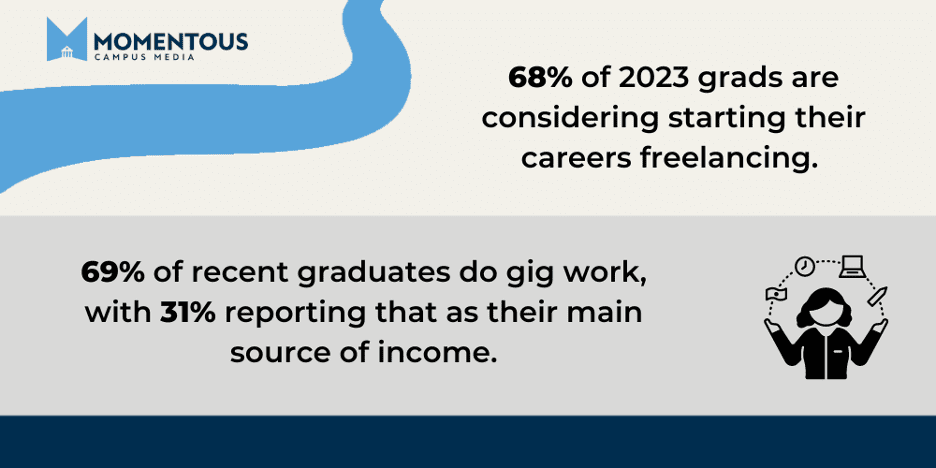
College Career Department Stats
- Students who used just one career center service received an average of 1.24 job offers, which increased by 0.05 offers for each additional service used. (Inside Higher Ed)
- 31% of students say they’ve never interacted with their college or university career center. (Inside Higher Ed)
- Of students who have interacted with career centers, most used it for career exploration or choosing a major (41%), followed by recruiting events (40%), developing a resume (39%) and making a career plan (28%). (Inside Higher Ed)
- 29% percent of institutions have implemented career readiness competencies institution-wide. (NACE)
- The median annual budget for a college career center was $417,595, up from $330,357 in the 2019–20 academic year. (NACE)





